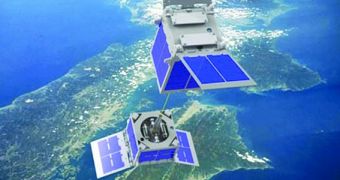Officials with the Japanese Aerospace Exploration Agency (JAXA) announced recently that they would soon start testing a new technological breakthrough in space tethering, an advancement that could one day enable us to clean the space debris currently cluttering Earth's orbit.
Space debris is slowly growing into a huge problem, since every rocket launch taking place from Earth adds some materials to the cloud of junk encircling our planet. Space tethering aims to solve this issue by grappling onto the largest debris and then destroying it through forced atmospheric reentry.
JAXA announced that the Space Tethered Autonomous Robotic Satellite (STARS) 2 electrodynamic tether experiment will launch into space alongside the NASA/JAXA Global Precipitation Measurement (GPM) Core Observatory satellite.
The spacecraft is scheduled to take off on February 28, from the Tanegashima Space Center, on Tanegashima Island, Japan. An H-II delivery system will ferry the satellite and STARS 2 into space. Once the main spacecraft is deployed, the experimental tether will be released as well.
JAXA hopes that the new technology demonstrator will enable low-cost orbital cleaning services. Most of the methods experts around the world have proposed to date are either very complex and expensive, or rely on technologies that are not yet available on a large scale, Space News reports.
STARS 2 consists of two 9-kilogram (20-pound) spacecraft that are tied together by a special wire. When fully outstretched, the wire will measure around 300 meters (985 feet), and will connect the two cubesats firmly together. The spacecraft were manufactured by experts at Kagawa University.
As the duo flies through our planet's magnetic field, electrical charges will accumulate alongside the electrodynamic tether between them. This extra voltage will interact with the magnetic field in a way that will generate either drag or propulsion for the host (or mother) spacecraft.
Many scientists believe that this approach could one day be used to deorbit large pieces of space junk, or to develop a new generation of propulsion systems that require no source of fuel. STARS 2 builds on the experience accumulated in January 2009, during JAXA's STARS 1 experiment.
Kagawa University experts revealed recently that the experimental tether is made up of multiple thin metal filaments, no more than 0.1 millimeters across. These strands are woven together to increase toughness and decrease weight, and are then wrapped in a net-like material that boosts structural integrity.
During its time in space, STARS 2 will also use its onboard cameras to snap images of our planet and then beam them back home through amateur radio frequencies. The two cubesats will fly in a nearly-perpendicular formation with regards to the surface of the planet, with the trailing spacecraft being stabilized by gravity.

 14 DAY TRIAL //
14 DAY TRIAL //